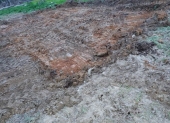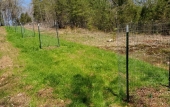So I have finished the bed today. After letting the first round of topsoil settle between the logs, I added some heavily amended topsoil on top of the whole area. I initially packed the soil down to allow me to assess the soil level and elevations, spread the soil out, and easily do my layout. So basically there is between six inches and a foot of soil on top of the logs depending on the spot, and the log layer is a foot or two deep everywhere.
I did my layout with four foot wide beds and two foot wide paths between them, which allowed me to comfortably fit 6 beds within the 40’ wide space. I ran the beds to about a foot from the edge, so about 22’ long in the 24’ long space. I dug out some of the higher places in the paths to get them reasonably level and smooth, and put the displaced dirt on the beds. Once I finished the layout and the flattening, I used my tractor and 4’ wide tiller to till the garden beds (one last time) before planting, which wouldn’t have been necessary except I had previously compacted the dirt during filling. The tractor tires stay in the "path" because they are wider than the tiller.
Once I finished that, I did mixed plantings of annual vegetables in the six wide beds. The beds got vine plants (squash, zucchini, butternut, cucumber, watermelon, pumpkin) to the south (to expand out), next tomatoes or peppers, and remaining large plants (Corn, okra, potatoes, peas, beans, popcorn) to the north. All of the beds got smaller plants mixed in along the sides, such as carrots, lettuce, celery, cilantro, and onions. The plants that were recommended for such had been started inside, the reminder were direct seeded.
Thus far, I am happy with the end result. Probably a few smaller things I would have done differently with hindsight, but I am hopeful the garden works well this year.





